NVIDIA Tegra 4 Architecture Deep Dive, Plus Tegra 4i, Icera i500 & Phoenix Hands On
by Anand Lal Shimpi & Brian Klug on February 24, 2013 3:00 PM ESTIt basically goes without saying, but Tegra 4i, formerly Grey, is primarily a story about the modem. About halfway through 2011, NVIDIA acquired Icera, a player in the handset cellular baseband market who had managed to fit a software-defined radio into the power budget for a mobile device. NVIDIA clearly recognized the importance of being able to deliver an SoC with an integrated modem, and after the Icera acquisition, and later Grey’s appearance on the roadmap, it just became a matter of when that would happen. NVIDIA executed pretty quickly, it turns out, and the fruits of that work manifest themselves in two products — Icera’s standalone i500 and Tegra 4i which contains the same i500 IP block, minus USB interfaces and a different memory subsystem.
Icera was an interesting player in the baseband space because their architecture was that of a software defined radio on the digital baseband side. The reality is that nobody is either fully software defined or burned out to ASIC (hardware), but rather somewhere inbetween. For example, Qualcomm is a combination of software and hardware, though it’s never been entirely clear what functional blocks are ASIC and which other blocks are software, though I’ve been told this is often a matter of whatever is most advantageous for power and what gets re-used most. That said, Icera’s implementation is the furthest towards being pure software defined of anyone, with the entire digital baseband being just one big platform to run their own software atop. There’s an external transceiver which does downconversion, but after that it’s pure software. The question has always been how Icera could afford to build a power competitive platform with an entirely software designed stack, and the clue lies in their choice of 28 HPM instead of LP or HPL silicon for i500 and 4i. Icera designs to a high performance process, then turns off blocks when they’re not in use, rather than make a larger SoC that’s lower leakage. The result is that NVIDIA claims a 40% smaller die for i500 than MDM9x15.
Icera has maintained the same software platform across its modem portfolio, each time taking advantage of increased processing performance afforded by faster silicon to include more air interfaces and capabilities. The result is an interesting advantage when it comes to operator certification — they can make a compelling case for each new version being close to the previous one, since they run the same PHY and protocol stack entirely in software.
In the case of i500, it runs the exact same multimode modem software as the i4xx series, just with increased DXP support for 15 and 20 MHz channel bandwidths on LTE.
The entire stack ends up being 1.2 million lines of C and DXP code, with a total size of 7.7 MB compiled. NVIDIA gave a great breakdown of the protocol stack as well.
The real name for Icera i500 is ICE9045, and it is paired with a ICE9245 transceiver. ICE9045 is built on 28nm HPM as I mentioned before, and ICE9245 remains 65nm TSMC LP CMOS process which is RF friendly. ICE9045 supports basically all the 3GPP air interfaces, as mentioned in the earlier announcement piece. There’s up to Category 3 LTE on the baseband at launch, with Category 4 in the future. For WCDMA, up to Category 24 (42 Mbps) (dual carrier with 64QAM), and interestingly enough the same Category 18 16 QAM with 2x2 MIMO (28 Mbps) as earlier implemented in Icera 450, and an optional future upgrade to Category 28 64 QAM with 2x2 MIMO (84 Mbps). Of course there’s also TD-SCDMA, GSM/EDGE, full support for voice including AMR-WB and VoLTE/IMS. In addition to 2x2 MIMO the ICE9045 can also do 4x4 MIMO on LTE with a second ICE9245 transceiver.
NVIDIA broke down the ICE9045 functionally, which consists of two large DXP units and one smaller DXP unit which runs the rest of the software and management stack. The two larger DXP units run at up to 1.3 GHz. The Icera instruction set consists of two different fundamental sets. Icera refers to these as the “C” and “D” side, with C being rather obvious. The C side is unsurprisingly a C-complier targeted version of the 3GPP protocol stack, and manages the higher level functions of the modem above physical interface, and is a scalar machine. In the block diagram, the C side runs on DXP1, the D side runs on the larger beefier DXP0 and DXP2 machines.
The D side is a proprietary assembly language vector instruction set that runs the physical layer of the modem, this is a combination of specific libraries that really make up the magic and give the Icera platform its reconfigurability. NVIDIA gave an excellent breakdown of the data paths inside both sides. It turns out that in an LTE configuration one core does all the inverse FFTs and MIMO matrix math, the second core does rate matching and decoding. The ultimate goal is to have each of the cores processing around the same equal workload, and since it’s software these tasks can be shuffled in-between to get the i500 running each core at the lowest possible frequency and voltage. Each of the cores can also be individually power collapsed.
On the transceiver side we have ICE9245 which is again TSMC 65nm LP CMOS. This talks over a digital interface to the baseband, and increases the number of primary RX ports from 6 to 8. All filtering and channelization is onboard the ISP. The goal is to keep all the A2D and D2A on the transceiver and away from the baseband. NVIDIA hasn’t quite given me the frequency breakdown for their low band, high band, and super high band, but you can figure it out just by looking. There’s also diversity ports for the same set of bands. All these ports are created equal and can handle 20 MHz LTE, in addition to inter-band and intra-band CA.
The big question is how well Icera’s i500 will stack up against the MDM9x15s and MDM9x25s of the world. Icera believes its ability to switch between four fundamentally different receiver types on the fly and dedicate processing to different functions based on the cellular geometry at the moment offers it an advantage in the long run.
NVIDIA demonstrated a Phoenix with Tegra 4i cabled up to a base station emulator doing full Category 3 LTE at 100 Mbps nice and steady. I asked whether they could go any higher to demonstrate the headroom in the current i500 architecture for upgrading to Category 4 and was shown just short of 120 Mbps on the two week old Tegra 4i silicon.


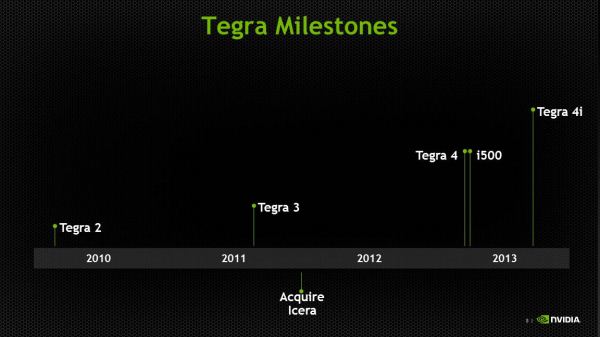
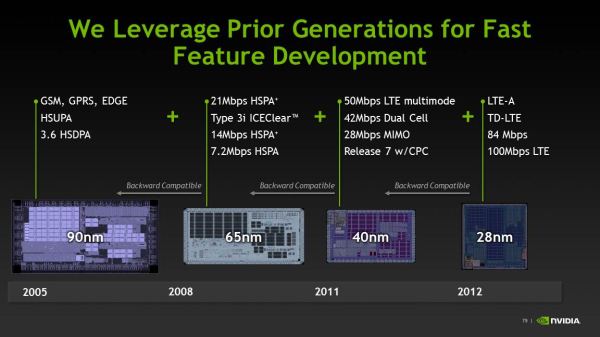
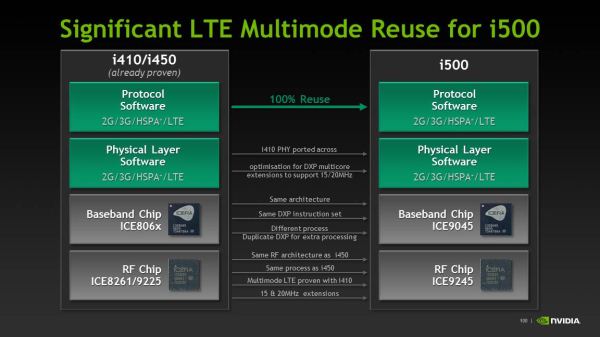
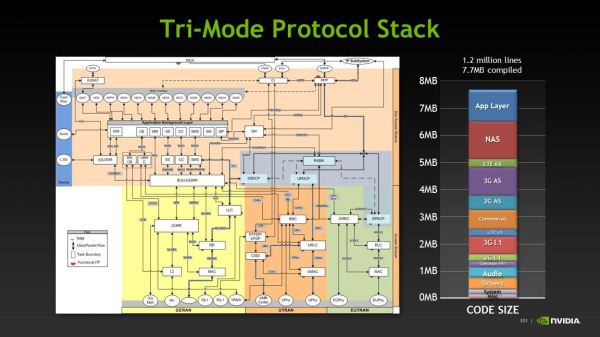
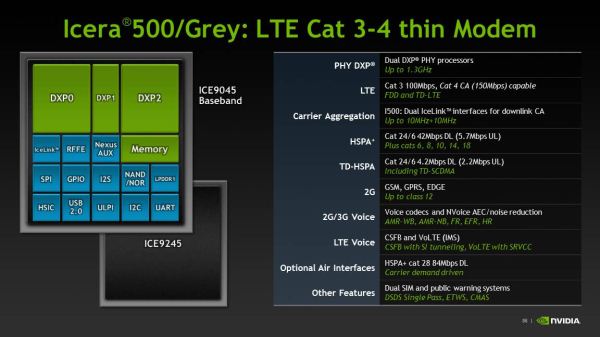
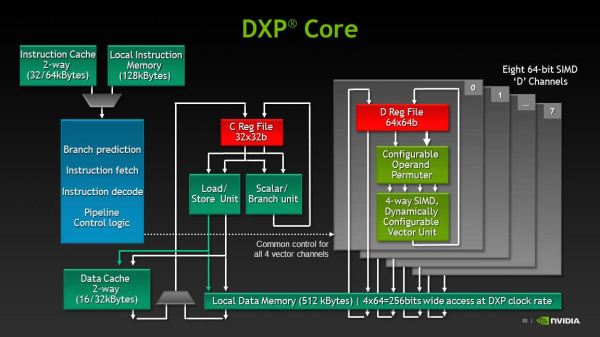
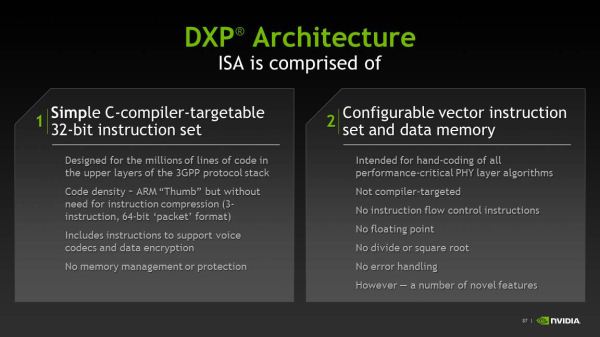
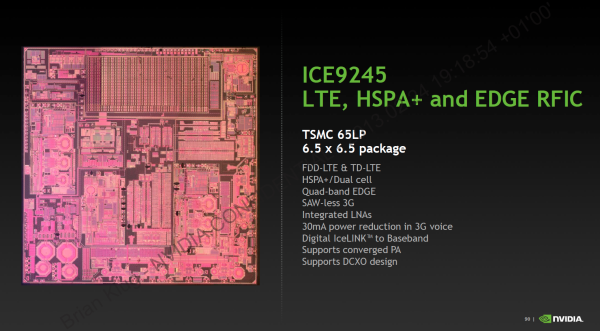
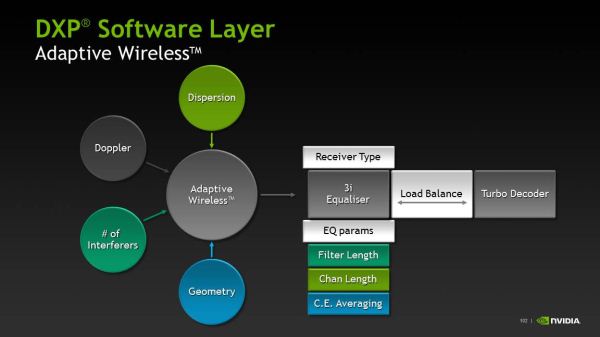















75 Comments
View All Comments
TheJian - Monday, February 25, 2013 - link
http://www.anandtech.com/show/6472/ipad-4-late-201...ipad4 scored 47 vs. 57 for T4 in egypt hd offscreen 1080p. I'd say it's more than competitive with ipad4. T4 scores 2.5x iphone5 in geekbench (4148 vs. 1640). So it's looking like it trumps A6 handily.
http://www.pcmag.com/article2/0,2817,2415809,00.as...
T4 should beat 600 in Antutu and browsermark. IF S800 is just an upclocked cpu and adreno 330 this is going to be a tight race in browsermark and a total killing for NV in antutu. 400mhz won't make up the 22678 for HTC ONE vs. T4's 36489. It will fall far short in antutu unless the gpu means a lot more than I think in that benchmark. I don't think S600 will beat T4 in anything. HTC ONE only uses 1.7ghz the spec sheet at QCOM says it can go up to 1.9ghz but that won't help from the beating it took according to pcmag. They said this:
"The first hint we've seen of Qualcomm's new generation comes in some benchmarks done on the HTC One, which uses Qualcomm's new 1.7-GHz Snapdragon 600 chipset - not the 800, but the next notch down. The Tegra 4 still destroys it."
Iphone5 got destroyed too. Geekbench on T4=4148 vs. iphone5=1640. OUCH.
Note samsung/qualcomm haven't let PC mag run their own benchmarks on Octa or S800. Nvidia is showing now signs of fear here. Does anyone have data on the cpu in Snapdragon800? Is the 400cpu in it just a 300cpu clocked up 400mhz because of the process or is it actually a different core? It kind of looks like this is just 400mhz more on the cpu with an adreno330 on top instead of 320 of S600.
http://www.qualcomm.com/snapdragon/processors/800-...
https://www.linleygroup.com/newsletters/newsletter...
"The Krait 300 provides new microarchitecture improvements that increase per-clock performance by 10–15% while pushing CPU speed from 1.5GHz to 1.7GHz. The Krait 400 extends the new microarchitecture to 2.3GHz by switching to TSMC's high-k metal gate (HKMG) process."
Anyone have anything showing the cpu is MORE than just 400mhz more on a new process? This sounds like no change in the chip itself. That article was Jan23 and Gwennap is pretty knowledgeable. Admittedly I didn't do a lot of digging yet (can't find much on 800 cpu specs, did most of my homework on S600 since it comes first).
We need some Rogue 6 data now too :) Lots of post on the G6100 in the last 18hrs...Still reading it all... ROFL (MWC is causing me to do a lot of reading today...). About 1/2 way through and most of it seems to just brag about opengl es3.0 and DX11.1 (not seeing much about perf). I'm guessing because NV doesn't have it on T4 :) It's not used yet, so I don't care but that's how I'd attack T4 in the news ;) Try running something from DX11.1 on a soc and I think we'll see a slide show (think crysis3 on a soc...LOL). I'd almost say the same for all of es3.0 being on. NV was wise to save die space here and do a simpler chip that can undercut prices of others. They're working on DX9_3 features in WinRT (hopefully MS will allow it). OpenGL ES3.0 & DX11.1 will be more important next xmas. Game devs won't be aiming at $600 phones for their games this xmas, they'll aim at mass market for the most part just like on a pc (where they aim at consoles DX9, then we get ports...LOL). It's a rare game that's aimed at GXT680/7970ghz and up. Crysis3? Most devs shoot far lower.
http://www.imgtec.com/corporate/newsdetail.asp?New...
No perf bragging just features...Odd while everyone else brags vs. their own old versions or other chips.
Qcom CMO goes all out:
http://www.phonearena.com/news/Qualcomm-CMO-disses...
"Nvidia just launched their Tegra 4, not sure when those will be in the market on a commercial basis, but we believe our Snapdragon 600 outperforms Nvidia’s Tegra 4. And we believe our Snapdragon 800 completely outstrips it and puts a new benchmark in place.
So, we clean Tegra 4′s clock. There’s nothing in Tegra 4 that we looked at and that looks interesting. Tegra 4 frankly, looks a lot like what we already have in S4 Pro..."
OOPS...I guess he needs to check the perf of tegra4 again. PCmag shows he's 600 chip got "DESTROYED" and all other competition "crushed". Why is Imagination not bragging about perf of G6100? Is it all about feature/api's without much more power? Note that page from phonearena is having issues (their server is) as I had to get it out of google cache just now from earlier. He's a marketing guy from Intel so you know, a "blue crystals" kind of guy :) The CTO would be bragging about perf I think if he had it. Anand C is fluff marketing guy from Intel (but he has a masters in engineering, he's just marketing it appears now and NOT throwing around data just "i believe" comments). One last note, Exynos octa got kicked out of Galaxy S4 because it overheated the phone according to the same site. So Octa is tablet only I guess? Galaxy S4 is a superphone and octa didn't work in it if what they said is true (rumored 1.9ghz rather than 1.7ghz HTC ONE version).
fteoath64 - Wednesday, February 27, 2013 - link
@TheJian: "ipad4 scored 47 vs. 57 for T4 in egypt hd offscreen 1080p. I'd say it's more than competitive with ipad4. T4 scores 2.5x iphone5 in geekbench (4148 vs. 1640). So it's looking like it trumps A6 handily."Good reference!. This shows T4 doing what it ought to in the tablet space as Apple's CPU release cycle tends to be 12 to 18 months, giving Nvidia lots of breathing room. Also besides, since Qualcomm launched all their new ranges, the next cycle is going to be a while. However, Qualcomm has so many design wins on their Snapdragons, it leaves little room for Nvidia and others to play. Is this why TI went out of this market ?. So could Amazon be candidate for T4i on their next tablet update ?.
PS: The issue with Apple putting quad PVR544 into iPad was to ensure the performance overall with retina is up to par with the non-retina version. Especially the Mini which is among the fastest tablet out there considering it needs to push less than a million pixels yet delivering a good 10 hours of use.
mayankleoboy1 - Tuesday, February 26, 2013 - link
Hey AnandTech, you never told us what is the "Project Thor" , that JHH let slip at CES..CeriseCogburn - Thursday, February 28, 2013 - link
This is how it goes for nVidia from, well we know whom at this point, meaning, it appears everyone here." I have to give NVIDIA credit, back when it introduced Tegra 3 I assumed its 4+1 architecture was surely a gimmick and to be very short lived. I remember asking NVIDIA’s Phil Carmack point blank at MWC 2012 whether or not NVIDIA would standardize on four cores for future SoCs. While I expected a typical PR response, Phil surprised me with an astounding yes. NVIDIA was committed to quad-core designs going forward. I still didn’t believe it, but here we are in 2013 with NVIDIA’s high-end and mainstream roadmaps both exclusively featuring quad-core SoCs. NVIDIA remained true to its word, and the more I think about it, the more the approach makes sense."
paraphrased: " They're lying to me, they lie, lie ,lie ,lie ,lie. (pass a year or two or three) Oh my it wasn't a lie. "
Rinse and repeat often and in overlapping fashion.
Love this place, and no one learns.
Here's a clue: It's AMD that has been lying it's yapper off to you for years on end.
Origin64 - Tuesday, March 12, 2013 - link
Wow. 120mbps LTE? I get a fifth of that through a cable at home.